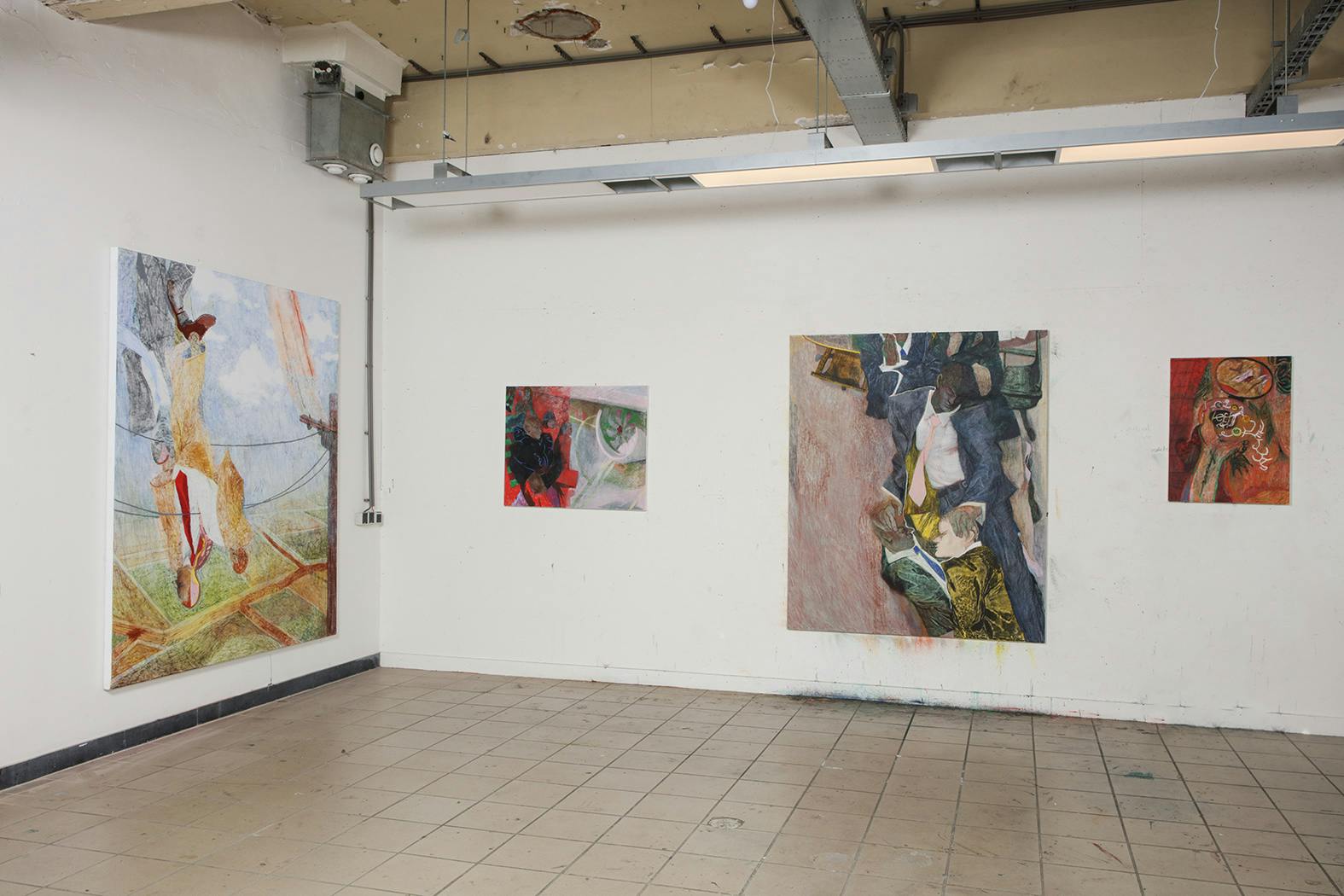
Diving, fleeing, falling, flying: Curchod’s paintings reject stillness, conveying instead a sense of urgency and movement. Between tangled office workers and lone swimmers, Curchod’s canvases defy the static medium of painting – each unfolding like a moving sequence.
Plunging into dark waters, colliding with a jet engine or falling from the sky, the scenes we witness are on the threshold of disaster, loaded with potential chaos. In Due cleanse we see a figure stepping forward on a diving board, hands clasped behind his back as if in sacrifice, or surrender, to the abyssal pool set to engulf him. His body looks unstable, his balance offset to the left – swathes of deep purple and blue dominate the canvas, frantic lines of colour are layered thickly in charcoal and pigmented oil stick. Curchod’s process is transparent, each mark visible, revealing layers of drawing beneath. This visual timeline of mark-making gives the canvas a sense of spontaneity and action through its own making, contributing to the overall dynamism that unifies the work.
During his time in Amsterdam, Curchod visited the the Johannes Vermeer exhibition at the Rijksmuseum. Renowned for his meticulous rendering of linear perspective, Vermeer captured seventeenth century Netherlands with precise realism, his technique for spatial accuracy situated firmly within the traditions of the Western canon. But for Curchod, spatial reality is just the thing he is deliberately denying. In a contemporary world where we are living more and more in unreality, online and virtually, the artist gives priority instead to constructing new and experimental space within his paintings.
The artist notes Persian miniatures as a consistent influence on his work, a form of painting that was at the height of its popularity in the East, at a similar time to when Vermeer was working in the West. In direct contrast to Vermeer, Persian miniaturists favoured multiple viewpoints, emphasising flattened or stacked space, over a realistic illusion of depth. We see this appreciation for experimental perspective in Curchod’s chosen references: Pierre Bonnard, Henri de Toulouse Latrec and R. B. Kitaj, all heralded for their more unconventional approaches to depicting spatiality.
In Today I made some friends at the office, we see multiple perspectives collide within one scene, wrestling male bodies merge into a corporeal tower, witnessed from frontal perspective. Their tangled limbs are suspended above desk chairs and a table’s edge, which we view from above, looking down. Suited in corporate workwear: white shirts and coloured ties, the male figures are sketched cartoonishly – sharp, bulging features cut into an uncomfortable grimace. Their stacked, elongated forms are reminiscent of Pieter Bruegel’s The Parable of the Blind (1568), a selected reference by Curchod. With distinctively similar murky palettes of grey, blue and brown, Curchod’s figures take lead from Bruegel’s claustrophobic line dance – the cloaks of Bruegel’s medieval men become Curchod’s corporate suits.
Written by Anna Eaves
References
1
2
3
4
5
Henry Curchod, The PPP / Oostmeijer Residency
July 12 – August 12, 2023